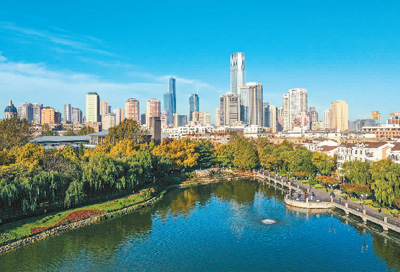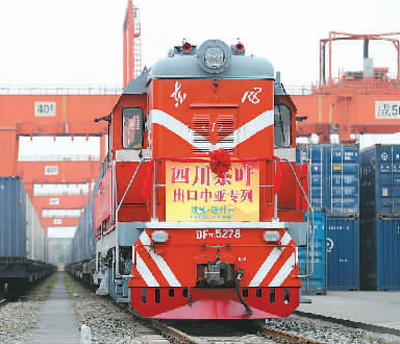Mega-cities have added new members, and the GDP of many cities exceeds 1 trillion yuan.

According to the data of the seventh national census published by the National Bureau of Statistics, the resident population of Dalian City in Liaoning Province reached 5.21 million, ranking among the megacities. The picture shows the scenery of downtown Dalian. Wang Huashe (People’s Vision)

In recent years, Kunming, the "Spring City", has a good momentum of high-quality development, and the ecological environment of Dianchi Lake has been continuously improved. The picture shows tourists watching the red-billed gull on the ridge dam in Dianchi Lake on November 21st. Xinhua News Agency reporter Chen Xinbo photo

The twin-city economic circle in Chengdu-Chongqing region is located at the intersection of the "Belt and Road" and the Yangtze River Economic Belt, and is the starting point of the new land and sea passage in the west. The picture shows that on November 22nd, the Sichuan Tea Export Central Asia Special Train departed from Chengdu International Railway Port to Tashkent, Uzbekistan. Photo by Bai Guibin (People’s Vision)
What are the mega cities in China? What is the economic development of these cities in the first three quarters of this year? Not long ago, based on the data of the seventh national census, the National Bureau of Statistics released the "Basic Situation of the Population of Megacities and Megacities in the Seventh National Census", showing that the "Club" of megacities in China has expanded again, including 7 megacities and 14 megacities in China. These cities are also remarkable in terms of economic development. Since the beginning of this year, they have handed in brilliant answers, and the GDP of many urban areas has exceeded 1 trillion yuan.
Re-expansion of clubs in megacities
What kind of cities are "megacities" and "megacities"? The National Bureau of Statistics explained that the scale of "mega-cities" and "mega-cities" is divided according to the "Notice of the State Council on Adjusting the Criteria for Urban Size Classification" issued in 2014: cities with more than 5 million urban residents and less than 10 million urban residents are megacities, and cities with more than 10 million urban residents are megacities; The urban population of each city is the population at the standard time of the seventh census (0: 00 on November 1, 2020).
Previously, according to the Statistical Yearbook of Urban Construction in 2019 released by the Ministry of Housing and Urban-Rural Development, China has 6 mega cities including Shanghai, Beijing, Chongqing, Guangzhou, Shenzhen and Tianjin, and 10 mega cities including Dongguan, Wuhan, Chengdu, Hangzhou, Nanjing, Zhengzhou, Xi ‘an, Jinan, Shenyang and Qingdao.
According to the data of "Seventh General Plan", four new members have been added to this mega-city "Club": the urban populations of Kunming, Changsha, Dalian and Harbin all exceed 5 million. At the same time, Chengdu ranks among the megacities with an urban population of 13.34 million. In addition, Wuhan ranks eighth in the list of megacities with an urban population of 9.95 million, only 50,000 people away from the "qualification" of megacities.
Why does the "club" of mega-cities expand again and again? "Sycamore trees attract golden phoenix", and population migration is an important reason. During the 10 years from "Sixth General Plan" to "Seventh General Plan", a large number of young people poured into mega-cities and injected fresh blood into urban development. In recent years, cities have launched a "war of grabbing people" to attract talents to work and settle down, and various attractive settlement policies are dizzying.
The high-quality development of regional economy has provided more development opportunities for all kinds of talents. Not long ago, the Central Committee of the Communist Party of China and the State Council issued the Planning Outline for the Construction of Twin Cities Economic Circle in Chengdu-Chongqing Region, which set the tone for writing a new chapter in Chengdu-Chongqing "Tale of Two Cities" and strengthened the confidence of many young people to develop here. "The ancients said ‘ Less into Shu ’ I think the city of Chengdu is also very suitable for struggle. Many young people around me like the pace of life and development opportunities here. " Chai Yun, a 27-year-old Chengdu youth who returned to his hometown after graduation, said.
"Young people have chosen this city, and this city will also bring surprises to young people who choose her." Chai Yun believes that the high-quality development of the twin-city economic circle in Chengdu-Chongqing region will reach a higher level in the future. In recent years, with the economic and social development of Chengdu-Chongqing region, the population size and economic aggregate of the western Gemini have been rising continuously. By the end of October, 67 major projects with a total investment of 1.57 trillion yuan had been started in Sichuan and Chongqing in 2021, with a cumulative investment of 186.68 billion yuan. This time, Chengdu has entered the ranks of megacities after Chongqing, which is expected by most people.
Dongguan, Shenzhen is "young", and Beijing and Shanghai are aging.
Megacity and megacity are not just a title.
On the one hand, the number of urban permanent residents is an important "threshold" for urban development and construction. It is understood that according to the relevant regulations, the resident population of urban areas that are currently applying for the construction of subways should be more than 3 million. At the same time, according to the regulations of the Ministry of Housing and Urban-Rural Development and the Emergency Management Department, cities with a permanent population of less than 3 million in urban areas are not allowed to build super-high-rise buildings with a height of more than 250 meters; Cities with a permanent population of more than 3 million shall not build super high-rise buildings of more than 500 meters.
On the other hand, megacities have played an important role in promoting China’s economic growth. Ning Ji Zhe, director of the National Bureau of Statistics, said earlier that since the reform and opening up, first-tier cities such as Beijing, Shanghai, Shenzhen and Guangzhou, as well as other super-large cities, have witnessed substantial economic growth, a significant increase in population, continuous opening-up and vigorous development of social undertakings, which have become an important engine for China’s economic growth, an important hub for opening up to the outside world and an important support for national governance.
The population structure of mega-cities has a far-reaching impact on the future development of cities and has attracted much attention.
Which cities are the youngest? According to the data of "Qipu", the proportion of people over 60 years old in Shenzhen and Dongguan is about 5%, which is significantly lower than that in other megacities.
Which cities have the most "silver-haired people"? Looking at the proportion of people over 60 years old, the two first-tier cities, Beijing and Shanghai, have a high degree of population aging. Shanghai’s population over the age of 60 accounts for 23.38%, ranking second among all megacities; The proportion of people over 60 in Beijing is also close to 20%. At the same time, most of the mega-cities with a population over 60 years old of more than 20% are located in the north, among which Dalian in the northeast ranks first, and the proportion of people over 60 years old in Harbin and Shenyang is also at a high level.
Lu Jiehua, a professor of sociology in Peking University, analyzed that the low fertility rate is the primary factor leading to the deepening of population aging in megacities. In addition, the higher supply level of old-age services in megacities attracts the elderly to settle down with their children, and the outflow of labor force also leads to the aging of some megacities.
Analysts pointed out that megacities have the opportunity to turn population aging into development opportunities. Among them, first-tier cities need to pay attention to cost and service. Ning Ji Zhe said that at present, the overall level of pension and social security in first-tier cities is relatively high, and the average life expectancy is above 80 years, ranking among the best in various cities. "What needs to be improved is to control costs and improve services".
"While controlling costs and improving services, we should also pay attention to the imbalance in the supply of old-age services between different cities." Lu Jiehua said that in first-tier cities and other megacities with high economic and social development level, the pension level and the income of the elderly are relatively high, and the inflow of young working people has largely offset the impact of the aging population, and the supply level of old-age services is relatively high and mutual assistance is strong. At the same time, the inflow of young people in some megacities represented by Northeast China is less, and compared with the former, it is "older" and "older faster", and the problem that the supply level of old-age services does not adapt to the process of population aging is prominent. To this end, we should promote a more balanced allocation of resources for aged care services among different cities.
Optimize and promote the core competitiveness of mega-cities
Not only does it attract population focus, but mega-cities also play an increasingly prominent role in leading regional economic development.
In the first three quarters of this year, the GDP of seven mega-cities including Shanghai, Beijing, Chongqing, Guangzhou, Shenzhen, Tianjin and Chengdu all exceeded 1 trillion yuan. Among them, Shanghai’s GDP first exceeded 3 trillion yuan, reaching 3,086.673 billion yuan. Beijing’s GDP in the first three quarters was 2,975.30 billion yuan. It is estimated that the annual GDP of the two places is expected to exceed 4 trillion yuan.
In the first three quarters of 14 mega-cities, the GDP of most of them reached more than 500 billion yuan, among which the GDP of Changsha, a "new member" of this mega-city, was 958.698 billion yuan in the first three quarters, which was close to the threshold of one trillion yuan.
During the 14th Five-Year Plan period, how to improve the spatial layout of urbanization and optimize the function of the central city of megacities? Ning Ji Zhe introduced that the relevant planning and deployment have the following points:
— — Promote the high-quality and sustainable development of megacities. Including promoting the transformation of development and construction methods in megacities and strengthening the prevention and control of urban governance risks; Promote the transformation of urban development mode from scale expansion to connotation promotion; Steadily improve the level of social security and the modernization level of urban governance; Strengthen the central radiation function of megacities, better promote rural revitalization and promote urban-rural integration and development.
— — Reasonably reduce the development intensity and population density of megacities. Orderly deconstruct the functions and facilities of general manufacturing, regional logistics bases, professional markets and over-concentrated public resources in the central city, and strengthen risk prevention and control in urban governance.
— — Optimize and promote the core competitiveness of mega-cities Strengthen the global resource allocation, the source of scientific and technological innovation and the leading function of high-end industries, take the lead in forming an industrial structure with modern service industry as the main body and advanced manufacturing industry as the support, and enhance the comprehensive energy level and international competitiveness.
Lu Jiehua believes: "The driving force and vitality of the development of mega-cities not only comes from scale expansion, but also from structural optimization and connotation improvement." He said that in the process of promoting the high-quality and sustainable development of mega-cities, on the one hand, it is necessary to scientifically plan the urban production, living and ecological space, optimize the spatial distribution of various facilities and functions, and strive to improve the population quality while reasonably reducing the population density; On the other hand, it is necessary to provide better basic public services, solidly practice the "basic skills" of urban development such as housing, education, medical care and old-age care, improve the level of social security and the modernization level of urban governance, and provide a stable guarantee for residents to live and work in peace and contentment. In addition, we should give full play to the role of agglomeration and radiation of mega-cities to better serve the optimization of spatial pattern of economic development and regional coordinated development, and drive the high-quality economic development of China.